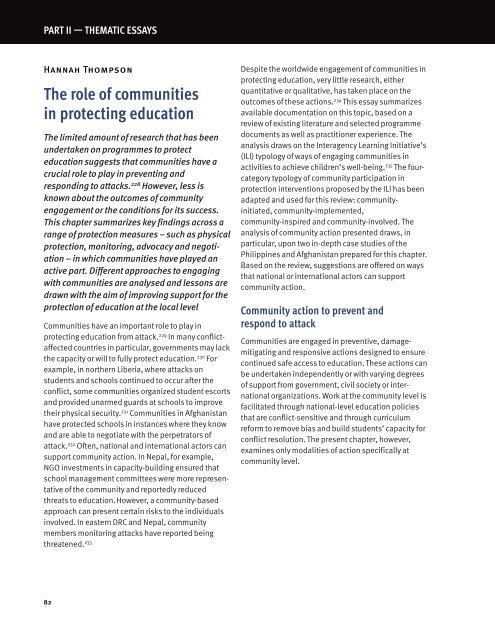You also want an ePaper? Increase the reach of your titles
YUMPU automatically turns print PDFs into web optimized ePapers that Google loves.
PART II — THeMATIC eSSAYS<br />
Hannah Thompson<br />
The role of communities<br />
in protecting education<br />
The limited amount of research that has been<br />
undertaken on programmes to protect<br />
education suggests that communities have a<br />
crucial role to play in preventing and<br />
responding to attacks. 228 However, less is<br />
known about the outcomes of community<br />
engagement or the conditions for its success.<br />
This chapter summarizes key findings across a<br />
range of protection measures – such as physical<br />
protection, monitoring, advocacy and negotiation<br />
– in which communities have played an<br />
active part. Different approaches to engaging<br />
with communities are analysed and lessons are<br />
drawn with the aim of improving support for the<br />
protection of education at the local level<br />
Communities have an important role to play in<br />
protecting education from attack. 229 In many conflictaffected<br />
countries in particular, governments may lack<br />
the capacity or will to fully protect education. 230 For<br />
example, in northern Liberia, where attacks on<br />
students and schools continued to occur after the<br />
conflict, some communities organized student escorts<br />
and provided unarmed guards at schools to improve<br />
their physical security. 231 Communities in Afghanistan<br />
have protected schools in instances where they know<br />
and are able to negotiate with the perpetrators of<br />
attack. 232 Often, national and international actors can<br />
support community action. In Nepal, for example,<br />
NGO investments in capacity-building ensured that<br />
school management committees were more representative<br />
of the community and reportedly reduced<br />
threats to education.However, a community-based<br />
approach can present certain risks to the individuals<br />
involved. In eastern DRC and Nepal, community<br />
members monitoring attacks have reported being<br />
threatened. 233<br />
Despite the worldwide engagement of communities in<br />
protecting education, very little research, either<br />
quantitative or qualitative, has taken place on the<br />
outcomes of these actions. 234 This essay summarizes<br />
available documentation on this topic, based on a<br />
review of existing literature and selected programme<br />
documents as well as practitioner experience. The<br />
analysis draws on the Interagency Learning Initiative’s<br />
(ILI) typology of ways of engaging communities in<br />
activities to achieve children’s well-being. 235 The fourcategory<br />
typology of community participation in<br />
protection interventions proposed by the ILI has been<br />
adapted and used for this review: communityinitiated,<br />
community-implemented,<br />
community-inspired and community-involved. The<br />
analysis of community action presented draws, in<br />
particular, upon two in-depth case studies of the<br />
Philippines and Afghanistan prepared for this chapter.<br />
Based on the review, suggestions are offered on ways<br />
that national or international actors can support<br />
community action.<br />
Community action to prevent and<br />
respond to attack<br />
Communities are engaged in preventive, damagemitigating<br />
and responsive actions designed to ensure<br />
continued safe access to education. These actions can<br />
be undertaken independently or with varying degrees<br />
of support from government, civil society or inter -<br />
national organizations. Work at the community level is<br />
facilitated through national-level education policies<br />
that are conflict-sensitive and through curriculum<br />
reform to remove bias and build students’ capacity for<br />
conflict resolution. The present chapter, however,<br />
examines only modalities of action specifically at<br />
community level.<br />
82


